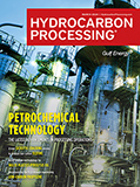Special Focus: Maintenance and Reliability
Many end users are trying to use feedstock with higher sulfur content for their refineries to increase profitability, but numerous unknown or plausible bottlenecks exist.
The steam system forms an integral part of the safe, reliable and profitable operation of a process plant. Steam constitutes approximately 30% of the energy used in a typical petroleum refinery.
Many challenges exist in maintaining instrumentation reliability.
Bulk hydrogen (H2) production in a petroleum refinery by steam methane reforming utilizes high temperatures, moderate pressures and catalyst-filled tubes that generate high tube temperatures of up to 920°C (1,690°F), imposing relatively harsh performance demands on system components.
Project Management
Numerous articles have been written about the key elements to a successful construction project.
Fluid Flow and Rotating Equipment
The objective of this article is to demonstrate the value of utilizing portable or permanently mounted ultrasonic flow measurement technology to measure and monitor high-energy pump hydraulic balance line flow.
Process Control and Instrumentation
Early detection of valve problems with diagnostics prevents small issues from escalating into major incidents when production starts.
Process Optimization
In the conventional development approach, a multi-stage process begins in the laboratory, moves to the pilot plant and then ends at the commercial unit, often before any financial benefits are realized.
The majority of dividing wall column (DWC) applications in the refining industry consist of standalone columns, whether a retrofit or a grassroots column.
As demand for oil products increases, refiners are expanding the capacity of their crude processing facilities to accommodate higher throughput.
Columns
Each May, Hydrocarbon Processing focuses on the topic of maintenance and reliability.
The second CCC implementation strategy involved so-called “shirt sleeve seminars.”
The prospect of peak oil demand will put pressure on resource-rich national oil companies (NOCs).
Brahmaputra Cracker and Polymer Ltd. (BCPL) is building the Assam Gas Cracker complex in Lepetkata, India.
Oil and gas professionals are well aware of the pressures companies face in the market.
Trends and Resources
Over the past several years, new gas processing/LNG capacity has surged in nearly every region.
Refining margins can be calculated using several different methodologies.
Atlantic Basin markets strengthened amid the onset of refinery maintenance season, while US support came from higher gasoline demand and gasoline price adjustments from the switch to summer RVP.
According to Hydrocarbon Processing’s Construction Boxscore Database, Asia, the Middle East and the US contain 66% of all active downstream construction projects globally.
Gulf Energy Information and Hydrocarbon Processing are pleased to provide a preview of IRPC Europe 2018, which will be held June 5–7 in Milan.
The following scenes were captured at several events that the editors of Hydrocarbon Processing attended over the past several weeks.
Susan Dio has been appointed Chairman and President of BP America Inc., BP’s chief representative in the US.

- India receives fuel oil cargo in Russian SCF tanker after brief halt 4/26
- Biden administration (U.S.) to release SAF tax credit model 4/26
- Boeing, Wagner advance Australia’s SAF Industry 4/26
- S-Oil expects Q2 refining margins to remain steady then trend upward 4/26
- Vitol to charter supertankers from U.S. to Nigeria's Dangote refinery 4/26
- Refiner Valero beats profit estimates on resilient demand, tight supplies 4/26





